High chances to catch Shingles after recovery from Chickenpox
July 23, 2014 by admin
Filed under Tips for Ayurveda
What is Shingles?
Shingles is caused by the varicella-zoster virus – the same virus that causes chickenpox. After recovery from chickenpox, the virus remains in the body and lies dormant in the central nervous system; which is made up of the brain and spinal cord. The virus may reappear in people of all ages who have previously had chickenpox.
The blisters are usually limited to one or more bands, called dermatomes, on one side of the trunk, around the waistline, or clustered on one side of the face.
The inactive virus may not cause problems for years, if ever. Shingles is most common in people over the age of 50, about half of all cases occur in men and woman age 60 years and older. The risk of disease increases as a person gets older.
How does Shingles occur?
Most people have chickenpox at some stage (usually as a child). The virus does not completely go after you have chickenpox. Some virus particles remain inactive in the nerve roots next to your spinal cord. They do no harm there, and cause no symptoms. For reasons that are not clear, the virus may begin to multiply again (reactivate). This is often years later. The reactivated virus travels along the nerve to the skin to cause shingles.
Typically individuals will develop one episode of shingles in their lifetime. The pain from shingles can be mild to severe, including burning, shooting pain or itching generally on one side of the body, does not cross over the midline of the body and visualizes as a rash or blisters. This indicates the dormant virus has reactivated and traveled from the nerves along a path to the skin, causing inflammation along the way. This pain can sometimes last for months post healing.
What are symptoms of Shingles?
The varicella-zoster virus usually affects one nerve only, on one side of the body. Symptoms occur in the area of skin that the nerve supplies. The usual symptoms are pain and a rash. Occasionally, two or three nerves next to each other are affected.
The pain is a localized band of pain. It can be anywhere on your body, depending on which nerve is affected. The pain can range from mild to severe. Other symptoms of shingles can include: fever, headache, sick feeling, extreme weakness, nausea, chills, fatigue, joint pain, faint due to weakness, etc.
The usual course of the illness is outlined below.
- Pain, tingling, numbness, itching on a specific part of the skin, on a single side of the body.
- A rash will typically appear 1-5 days after the pain begins.
- Red spots emerge that develop into itchy fluid-filled blisters.
- The rash has the appearance of chickenpox but only on the band of skin supplied by the affected nerve.
- The rash may involve the face, eyes, mouth and ears in some cases.
- Sometimes the blisters merge, forming a solid red band that looks like a severe burn.
- New blisters may arise for up to a week.
- Inflammation/swelling may be caused in the soft tissue under and around the rash.
- People with lesions may feel spasms of pain at the gentlest touch or breeze
- The blisters will gradually dry up, form scabs or crusts and begin to fade in 7-10 days
- Minor scarring may occur where the blisters have been.
- A shingles episode can often last between 2 and 4 weeks.
Is Shingles contagious?
Shingles is not spread through coughing or sneezing but through direct contact with fluid from the filled blisters. Before the blisters develop and after the crusts form, the person is not contagious.
You can catch chickenpox from someone with shingles if you have not had chickenpox before. But most adults and older children have already had chickenpox, and so are immune. You cannot get shingles from someone who has shingles.
Preventative measures for Shingles include:
- Keeping the rash covered
- Minimal scratching or contact with the rash
- Regular hand-washing
- Avoiding contact with Pregnant women who have never had chickenpox or varicella vaccine
- Avoiding contact with Premature or low birth weight infants
Ayurvedic treatment for Shingles
Many people opt for Ayurvedic treatment for Shingles because it has no side effects. Ayurveda, which is often called the Mother of all Medicine recommends few ointments on the skin. One of the most common herbal remedies for shingles includes application of a paste of turmeric powder on the affected area. Being a natural antiseptic, turmeric speeds up healing and relieves the sufferer from pain. The other popular home remedy is application of 1 cup of aloe vera gel mixed with 1 tspn of honey. Apply on the affected area 2 times a day.
Shingles is less contagious than chickenpox. The risk of spreading the virus is low if the rash is covered. However the infected person may require rest due to body pains and a general ill feeling.
Please add a comment and, if you like the post, feel free to share it with your friends.You can also visit our Facebook page and Google plus page for more insight on other articles.
Menopause-What to expect if you are between 40 to 55 years
July 9, 2014 by admin
Filed under Tips for Ayurveda
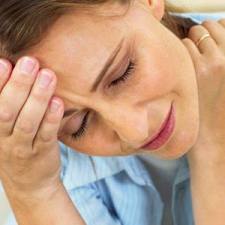 Menopause is a natural transition in women that occurs at the age of 40-55 years. The menstrual cycle stops and sex hormone levels decrease, including that of estrogen, resulting in the condition called menopause. Menopause is not a disease. In Ayurveda, menopause is described as a natural effect of aging and does not reflect any disease.
Menopause is a natural transition in women that occurs at the age of 40-55 years. The menstrual cycle stops and sex hormone levels decrease, including that of estrogen, resulting in the condition called menopause. Menopause is not a disease. In Ayurveda, menopause is described as a natural effect of aging and does not reflect any disease.
There are lot of stories shared by our elders and friends that the thought of going thru’ the stages of menopause is so scary. While some women sail through menopause comfortably, others struggle to deal with its annoying or even unbearable symptoms. Let’s understand to have a clarity on menopausal stages in a women’s life.
Symptoms of Menopause
Menopause symptoms varies from person a woman to woman. This is due to differences in lifestyle, attitude, genetics, weight, and customs. However a few symptoms are almost universally experienced.
Hot Flashes
A hot flash is the body’s response to our decreasing estrogen levels. It is experienced as a It can be felt as a slight warming, slowing rising up and over your entire body; or it can be a raging fire from the depths, consuming your entire body. Either way the warming is felt , this reaction is completely normal and more than 50% of women going through menopause suffer from hot flashes.
Night Sweats
Night sweats occur for the same reason as their close friend, the hot flash, and cause extreme night time perspiration and discomfort. You will not be able to have a sound sleep due to being uncomfortable. They are clinically called nocturnal hyperhydrosis. Nocturnal meaning “night”, hyper meaning “too much” and hydrosis meaning “water condition.”
Loss of Sex Drive
Due to the hormonal changes in our bodies, you may experience a loss of libido (sex drive). The key to getting through this is to be open and honest with your partner about the reasons you may not be in a mood these days.
Irregular Menstruation
The main cause of menstrual irregularities of any type is a hormonal imbalance. In menopause, the main contributor is estrogen and its decreasing levels in our system. You may experience periods more frequently or less; and they may be heavier (clots) or lighter.
Vaginal Dryness
Dryness in vagina is a common observation by most women. Along with the loss of moisture and dry feeling comes a loss in elasticity as well. You may be prone to repeated vaginal infections easily, loss of bladder control and having sex may become a pain, literally.
Mood Swings
You are going through an emotional pendulum with the changes in moods. You could be prone to tears and angry outbursts for no apparent reason, and believe it or not, this is a normal symptom of menopause.
Tiredness
You will feel exhausted quickly. Your low energy and tiredness are all symptoms of menopause setting in. You will long to take a nap at any time of the day. This tiredness and exhaustion can be described by women only.
Stages of Menopause
Perimenopause
Perimenopause is the stage that many women go through before hitting full-fledged menopause. The symptoms of menopause can begin as early as your 30’s or 40’s. Symptoms like the hot flashes and night sweats are common early on in a period called perimenopause. It usually happens four or five years prior to the onset of menopause, but in some women, it happens much earlier.
Menopause
Actual menopause usually begins in your 40’s or 50’s, when it occurs naturally. Surgical menopause occurs when a woman needs to have a hysterectomy and a bilateral oophorectomy (removal of both ovaries). Women who go through surgical menopause have a far worse time than those who go through it naturally. Their body is thrown into a hormonal imbalance, instead of eased into it and this can make the symptoms much more severe.
Post Menopause
Post menopause is considered to be a full year after the menstrual cycle has ceased to occur by most Doctors. During post menopause you can look forward to a lessening or complete suppression of the symptoms.
Lifestyle tips for balance
- Follow a strict routine: According to Ayurveda,sleep is important for the woman entering menopause or going through menopause, because both Vata and Pitta imbalances can cause sleep problems that will only make menopausal imbalances worse. To balance both the doshas and to have a good sleep, be sure you’re in bed before 10 p.m and that you arise before 6 a.m. This is the time of night when sleep comes easier and is more restful. If you stay awake past 10 o’clock, it will be harder to fall asleep, and you’ll also increase any Pitta imbalance, because 10 p.m to 2 a.m is the Pitta time of night, when the body needs to be at rest in order to cleanse and purify itself.
- For both Pitta and Vata dosha, it’s important not to skip meals, and to eat your main meal at noon, when digestion is the strongest. Try to eat at the same time every day, and go to bed and wake up at the same time.
- Be sure to get lots of rest during your menstrual cycle as you approach menopause, because this will keep Apana Vata in balance and avoid the more serious complications of menopause.
- Daily exercise is also important for keeping all doshas in balance. Do yoga or meditation if you cannot go out for walking.
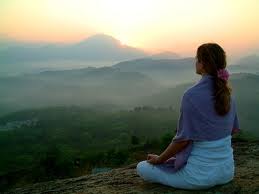
- Oil massage twice a week will increase circulation, calm Vata dosha, and provide needed moisture to the skin.
- Drink lots of water. Minimize on caffeine intake and avoid alcohol to keep Vata dosha in control
Consult a doctor for medical advice if you observe varying conditions that are not manageable. At times a friendly talk or guidance from a counselor will do wonders rather than medicine.
Take out time for yourself. Minimize stress and you can control the hormonal imbalances to a large extent.
Benefits of Eating with Fingers
July 5, 2014 by admin
Filed under Tips for Ayurveda
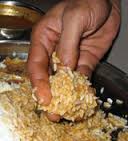 Why should we eat with our fingers? Indians follow this tradition of eating with hands all across India. Eating food with your hands not only feeds the body but also the mind and the spirit. The logic behind this practice is the Vedic interpretation. In the printed paper ‘Vedic wisdom behind eating with your hands’ it mentions that “Our hands and feet are said to be the conduits of the five elements”.
Why should we eat with our fingers? Indians follow this tradition of eating with hands all across India. Eating food with your hands not only feeds the body but also the mind and the spirit. The logic behind this practice is the Vedic interpretation. In the printed paper ‘Vedic wisdom behind eating with your hands’ it mentions that “Our hands and feet are said to be the conduits of the five elements”.
Vedic Interpretation
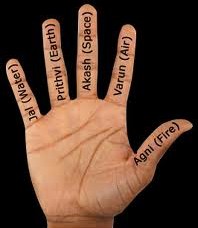 Ayurvedic texts teach that each finger is an extension of one of the five elements. The thumb is agni (fire). Children suck their thumb, this is nature’s way of aiding the digestion at an age when they are unable to chew; the forefinger is vayu (air), the middle finger is akash (ether ) i.e the tiny intercellular spaces in the human body; the ring finger is prithvi (earth) and the little finger is jal (water)
Ayurvedic texts teach that each finger is an extension of one of the five elements. The thumb is agni (fire). Children suck their thumb, this is nature’s way of aiding the digestion at an age when they are unable to chew; the forefinger is vayu (air), the middle finger is akash (ether ) i.e the tiny intercellular spaces in the human body; the ring finger is prithvi (earth) and the little finger is jal (water)
Childhood practices-eating with fingers
In our childhood days parents were always behind us to hold all fingers together while transferring the morsel into the mouth. Now you can also understand the essence of this practice. All the five elements will come into play by properly placing fingers together and it affects our digestive system.
Personal hygiene
Eating with one’s hands means following a good level of personal hygiene. It forces one to wash their hands before and after the meals. It’s believed that the touch, sight, sense and taste that can be drawn with one’s hands cannot be achieved with the aid of a fork, knife or spoon.
Apart from washing the hands, one should have clean fingernails as well. In fact, long fingernails are considered unhygienic in some countries, especially India. Besides this, the right hand is always used for eating because the left hand is considered unclean for eating purpose. The left hand that is idle during eating process actually aids to serve food during meals.
Benefits and Ergonomics
Eating with your fingers helps you to judge the temperature of the morsel and rules out the possibility of an ulcer or a scalded tongue. Sitting on the floor and eating rather than a dining table is recommended because the repeated bending of the spine improves blood circulation and digestion. Prevents the morsel falling onto your clothes.
The staple diet in India includes rice, dal, chapathi. Eating chapathi and sabzi with hands is convenient rather than a fork and spoon.
Impact on digestive system
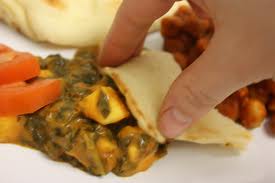 Each finger aids in the transformation of food, before it passes on to internal digestion. Gathering the fingertips as they touch the food stimulates the five elements and invites Agni to bring forth the digestive juices. As well as improving digestion the person becomes more conscious of the tastes, textures and smells of the foods they are eating, which all adds to the pleasure of eating.
Each finger aids in the transformation of food, before it passes on to internal digestion. Gathering the fingertips as they touch the food stimulates the five elements and invites Agni to bring forth the digestive juices. As well as improving digestion the person becomes more conscious of the tastes, textures and smells of the foods they are eating, which all adds to the pleasure of eating.
The five fingers also represents taste like sweet, sour, bitter, salty and spicy. Therefore even if you are a newbie to the practice of eating with your hands, do make an attempt.
You can also read:
Karkidam-Monsoon is the ideal season for Ayurvedic treatments in India?
Simple ways to include Ayurveda in everyday life
Benefits of Drinking Water before Bedtime
Simple steps of Ayurveda for Good Health
How to be healthy this Rainy season
Tell us if you liked the article. Watch out for our Facebook page and Google+ page.
Looking forward to hear your valuable inputs and comments.







